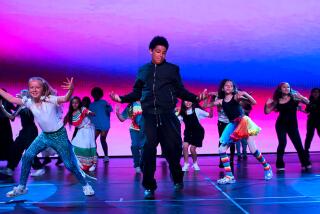DANCE REVIEW : ‘Kaleidoscope’ Folk Program
“Dance Kaleidoscope” was born as a sprawling, something-for-everyone grab-bag--a variety show in which the most distinctive segments invariably cancelled one another out.
No longer. After nine editions plus a couple of years off, this annual showcase for local companies has dared to organize its resources. Not only did the Sunday afternoon “Kaleidoscope” program at Cal State L.A. (to be repeated Friday evening) achieve admirable balance and unity, it focused on Southern California’s most thriving dance community.
Our folk/ethnic/world dance scene (choose a label) is varied enough to be deemed kaleidoscopic, yet shares a technical standard and sense of national identity that local ballet and modern dance haven’t yet attained. Marred only by major sound glitches, the performance Sunday had spectacle, virtuosity and humor to recommend it.
Its greatest glory may have been “Katona Kisero,” by Karpatok Hungarian Dance Company: a suite choreographed by Don Sparks and Tibor Toghia that evolved from a simple farewell procession for two soldiers into effervescent display dances for ten couples without losing its sense of leavetaking.
This contextual, slice-of-life dimension made the social dances warmer and brighter than they would have seemed in isolation. Yet isolation was exactly the context that Anthony Shay chose for his Avaz Dance Theatre repertory--and he made you grateful. Like a private collector showing off his treasures, Shay introduced his dances and summarized their value, helping us see familiar Avaz artifacts from Eastern and Central Croatia, Saudi Arabia and Uzbekistan with his enlightened curatorial perception.
Ballet Folklorico del Sur de California offered group dances from Oaxaca and Jalisco, fluently choreographed by Deanna Nunez. The women’s gliding steps in “La Zandunga” immediately established the group’s unforced proficiency, a quality heightened in the sustained unison footwork of the full-company finale.
Only the flirtation trio for Deanna and Ramon Nunez with Sylvia Venegas strayed into audience-courting, showbiz territory--definitely not a province of Mexico.
Two of Southern California’s best known flamenco artists completed the program in separate sets: the hyper-glamorous Linda Vega and the hyper-intense Juan Talavera. Each used the same accompanists (guitarists Antonio Duran and Antonio de Triana, along with singer Antonio Aleazar).
Vega took you by surprise, Talavera by force. Her “Garrotin” and “Bulerias” solos reveled in unexpected turns, sudden-death changes of impetus and a knack for making the most difficult displays look thrown away. Singer Pilar Moreno greatly enhanced the sense of volatile female expression.
In contrast, Talavera often seemed to be constructing an impenetrable edifice out of steps--each footfall powerful yet meticulously measured. Early on in his “Martinete por Siguiriya,” he danced accompanied only by anvil-blows and voice, with the metallic clang providing a gritty, proletarian context for his driving heelwork.
More to Read
The biggest entertainment stories
Get our big stories about Hollywood, film, television, music, arts, culture and more right in your inbox as soon as they publish.
You may occasionally receive promotional content from the Los Angeles Times.










